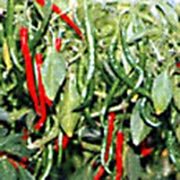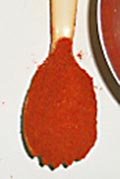Cayenne pepper Nutrition facts
Cayenne pepper, known for its intense heat and pungent flavor, is a commonly employed spice in various culinary traditions. These elongated, slender pods are harvested from plants within the capsicum family.
The Cayenne variety of chili pepper plants is native to the Central American region where it employed as a spicy ingredient in the cuisine for several thousand years. It was introduced to the rest of the world, especially to the Indian subcontinent, by Spanish and Portuguese explorers during the 16th and 17th centuries. They are now one of the important commercial crops grown in India, Pakistan, China, Argentina, and the US
Botanically, cayenne plant belongs to the nightshade family of Solanaceae, in the genus; capsicum. Scientific name: Capsicum annuum var. annuum.
 |
 |
| Cayenne chili peppers in capsicum annuum plant. Note for long, slender chili pods. | Cayenne pepper powder. |
Cayenne pepper is a small perennial shrub, reaching about 90-100 cm in height. It prefers well-drained sandy soil and a warm climate. Its woody stem with numerous branches covered with thick dark-green foliage. Small creamy-white flowers appear all over the bush, which subsequently develop into long, slender, glossy, bright-green fruits (pods). The fruits finally attained mature status when they turned a deep-red color.
Interiorly, each cayenne fruit features numerous tiny, flat, disk-shaped, off-white, or cream-colored seeds. The seeds are actually clinging to the central white placenta.
In general, the cayenne chili peppers are allowed to ripen completely on the plant itself and handpicked once matured and red. They are then left to dry, which makes them shrivel.
Cayenne chilies have a strong pungent taste that comes from active alkaloid compounds capsaicin, capsanthin, and capsorubin. The hotness of cayenne is measured in “Scoville heat units” (SHU). On the Scoville scale, cayenne pepper has 30,000 to 50,000 SHU. On comparison scale, bell peppers have "zero" SHU.
9 amazing Health benefits of Cayenne peppers
Although inherently hot and intolerable even in small amounts, cayennes are one of the health-benefiting spice items packed with minerals, vitamins, and certain phytonutrients. They found use in modern as well as traditional medicines for their disease-preventing and health-promoting properties.
Cayenne contains health benefiting alkaloid compound, capsaicin which gives them a strong spicy pungent character. Early laboratory studies on experimental mammals suggest that capsaicin has anti-bacterial, anti-carcinogenic, analgesic, and anti-diabetic properties. When used judiciously, it is also found to reduce triglycerides and LDL cholesterol levels in obese individuals.
Fresh cayenne peppers, red or green, are a rich source of vitamin-C. 100 g fresh chilies provide about 76.4 mg or about 127% of RDA of this vitamin.
Vitamin C is a potent water-soluble antioxidant. It is required for collagen synthesis in the body. Collagen is one of the main structural proteins maintaining the integrity of blood vessels, skin, organs, and bones. Regular consumption of foods rich in vitamin C helps the body protect from scurvy, develop resistance against infectious agents (boosts immunity), and scavenge harmful, pro-inflammatory free radicals from the human body.
Cayenne chili peppers are perhaps the richest source of vitamin-A among spices. Just 100 g of cayenne has 41,610 IU or astoundingly 1387% of vitamin A.
Additionally, this prized spice is also home to antioxidant flavonoids such as carotenes, lutein, zeaxanthin, and cryptoxanthin. Together, these antioxidants in cayenne help to protect the body from the injurious effects of free radicals generated during stress, and disease conditions.
The spice contains very high levels of essential minerals. Even in small quantities, it would provide enough iron, copper, zinc, potassium, manganese, magnesium, and selenium. Manganese is a co-factor for the antioxidant enzyme superoxide dismutase. Selenium is an antioxidant trace element required by the human body for optimum heart and liver functions.
100 g of cayenne peppers provides 2014 mg or 47% of a daily-required amount of potassium. Potassium is an important electrolyte in the cells and body fluids that help control heart rate and blood pressure. It thus, counters the bad effects of sodium.
Cayenne peppers are also good in the B-complex group of vitamins such as niacin, pyridoxine (vitamin B-6), riboflavin, and thiamin (vitamin B-1). These vitamins are essential in the sense that the body requires them from external sources to replenish. B-complex vitamins facilitate cellular metabolism through various enzymatic functions.
Cayenne peppers have amazingly very high levels of vitamins and minerals. Just 100 g provides (in % of Recommended daily allowance):
127% of vitamin-C (Ascorbic acid),39% of vitamin B-6 (Pyridoxine),
54% of niacin,
71% of riboflavin,
1387% of vitamin A,
97.5% of iron,
41% of copper,
43% of potassium,
however, no cholesterol.
| Principle | Nutrient Value | Percent of RDA |
|---|---|---|
| Energy | 318 Kcal | 16% |
| Carbohydrates | 56.63 g | 43% |
| Protein | 12.01 g | 21% |
| Total Fat | 17.27 g | 57.56% |
| Cholesterol | 0 mg | 0% |
| Dietary Fiber | 27.2 g | 71% |
| Vitamins | ||
| Folates | 106 mcg | 26% |
| Niacin | 8.701 mg | 54% |
| Pyridoxine | 2.450 mg | 39% |
| Riboflavin | 0.919 | 71% |
| Thiamin | 0.328 mg | 27% |
| Vitamin A | 41610 IU | 1387% |
| Vitamin C | 76.4 mg | 127% |
| Vitamin E | 29.83 mg | 199% |
| Vitamin K | 80.3 mg | 67% |
| Electrolytes | ||
| Sodium | 30 mg | 2% |
| Potassium | 2014 mg | 43% |
| Minerals | ||
| Calcium | 148 mg | 15 % |
| Copper | 0.373 mg | 41% |
| Iron | 7.80 mg | 97.5% |
| Magnesium | 152 mg | 38% |
| Manganese | 2.00 mg | 87% |
| Phosphorus | 293 mg | 42% |
| Selenium | 8.8 mcg | 18% |
| Zinc | 2.48 mg | 22.5% |
| Phyto-nutrients | ||
| Carotene-ß | 21840 µg | -- |
| Carotene-α | 0 µg | -- |
| Cryptoxanthin-ß | 6252 µg | -- |
| Lutein-zeaxanthin | 13157 µg | -- |
Selection and storage
Cayenne peppers can be available year-round in the markets in fresh, either green or red, dried or powdered form. In the stores, buy fresh whole pepper pods instead of powder since oftentimes it may contain some adulterated spice substances.
Look for raw, fresh chilies featuring brilliant red color with healthy stem, wholesome and compact. Avoid the pods with spots or those spoiled tips inflicted by molds.
Once at home, they should be stored inside the refrigerator in a plastic bag where they will stay fresh for about a week.
Dry, whole red cayenne peppers are also available in the markets. Dry peppers can be stored at room temperature in a cool, dark place, in airtight containers for several months. They can be milled using a handmill as and when required. If you want to buy dry powder instead, go for authentic and branded products. Powdered cayenne pepper should be stored in a cool place inside airtight containers.
Medicinal uses
Cayenne peppers contain the chemical compound capsaicin. Capsaicin and its co-compounds are employed in the preparation of ointments, rubs, and tinctures for their astringent, counter-irritant, and analgesic properties.
These formulations have been in use in the treatment of arthritic pain, post-herpetic neuropathic pain, sore muscles, etc.
Scientific studies on experimental mammals suggest that capsaicin has antibacterial, anti-carcinogenic, analgesic, and anti-diabetic properties.
The spice is also one of the ingredients in the modern-day weight-reduction "cayenne pepper diet" program along with lemon juice, laxative tea, etc. Some poorly established research studies suggest that cayenne pepper has been found to reduce blood sugar levels, and LDL cholesterol levels, and bring weight reduction in obese.
Culinary uses
In many South Asian countries, raw, fresh, or dried cayenne chilies are employed in the preparation of sauce, chutney, chili water, and pickles. Whereas, it's a milled (powder) spice preferred in Mexican, Mediterranean, and American cooking.
Wash raw red cayenne in clean water before cooking to remove any residual fungicides, sand, and dirt. Handle chiles carefully! Cayenne chilies, either as fresh or ground, can cause a serious burning sensation to hands and may cause severe irritation to mouth/nasal passages, eyes, and throat. Therefore, it may be advised to use thin hand gloves and face masks while handling them in some sensitive individuals.
Here are some serving tips:
Fresh raw cayenne peppers are being used as vegetables in the cuisines in many parts of South Asia, especially in the southern states of India. Here, they liberally mixed with other vegetables like potato, okra, pumpkin, green beans, etc., along with tomato, garlic, onion, cumin seeds and other spices in many mouth-watering sabzi, stews, and stir-fries.
Cayenne, chopped and ground, is used as a condiment in the preparation of pepper sauce, soups, and curries and to marinate meat, fish, and poultry.
Dried cayenne chili powder is an essential ingredient in Cajun spice mix or just known as 'curry powder' in many Asian countries.
Thin slices of cayenne chilies flavored mix in Chinese-style vegetable stir-fries and noodles.
Cayenne chilies, soaked in yogurt and salted, then dried under sunlight, are used as side snacks during dinner in South Indian states.
Safety profile
The pungency (hotness) level of cayenne peppers is in the range of 30,000-50,000 SHU. The pungent character is due to the active component in them, capsaicin, which when eaten causes severe irritation, and a hot sensation to the mouth, tongue, and throat.
Capsaicin in cayenne chilies initially elicits inflammation when it comes in contact with the delicate mucosa of the oral cavity, throat, and stomach, and soon produces a severe burning sensation that is perceived as ‘hot’ through free nerve endings in the mucosa. Cold yogurt can help reduce the burning pain by diluting capsaicin concentration and also preventing its contact with gut walls.
Avoid touching eyes with cayenne pepper-contaminated fingers. If so, rinse your eyes thoroughly in the cold water to reduce irritation.
They may aggravate existing gastroesophageal reflux (GER) condition.
Certain chemical compounds like aflatoxin (fungal mold), found in old, spoiled cayenne chilies have been known to cause stomach, liver, and colon cancers. (Mediacal Disclaimer).
Also read ≻≻-
≻≻- Chili peppers nutrition facts.
≻≻- Jalapeno peppers nutrition facts.
≻≻- Back to Spicesfrom Cayenne pepper. Visit here for impressive list of Spices with complete illustrations of their nutrition facts, medicinal properties and health benefits.
≻≻- Back to Home page.
Further Resources:
USDA National Nutrient Database. (opens in new window)
Gernot-Katzer's spice pages. (Opens in new window)